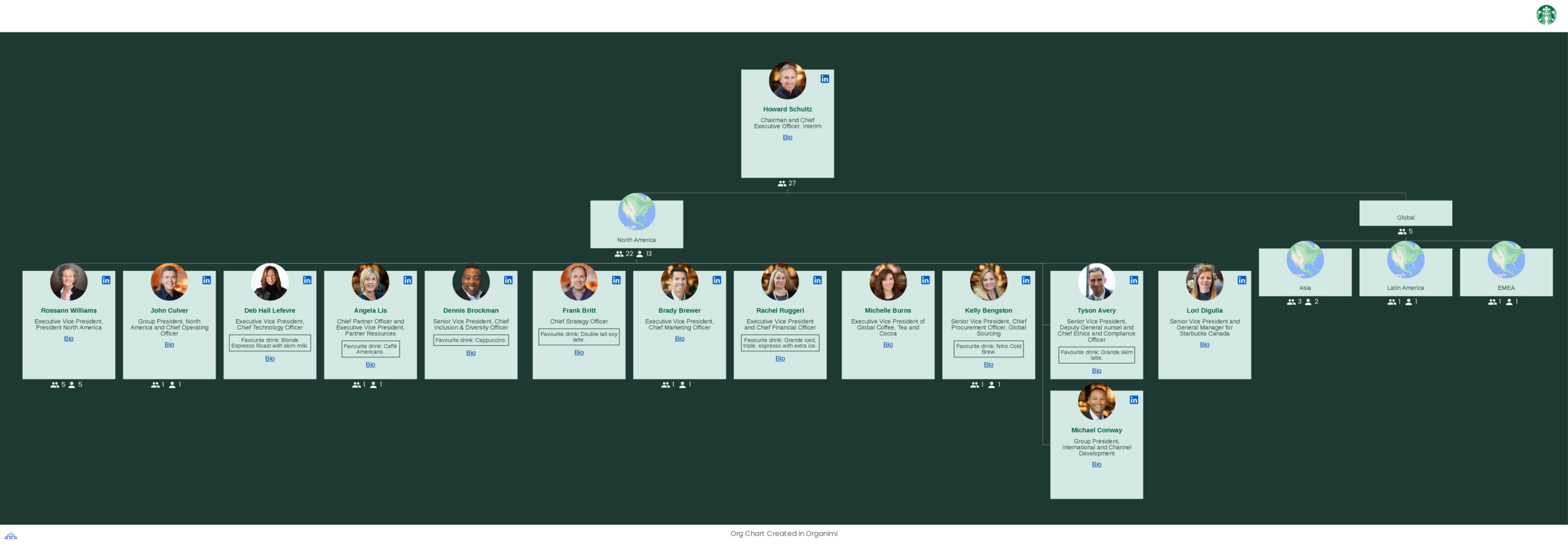Starbucks’ Organizational Structure
Create this exact chart in Organimi! Scroll below to see how.
Introduction
Starbucks is an American chain of coffeehouses and roasteries headquartered in Seattle, Washington. Founded in 1971, it is one of the world’s largest coffee chains with over 33,800 stores in 80 countries. Almost half of these are located in the United States.
Founded by Jerry Baldwin, Zev Siegel, and Gordon Bowker initially as a trader of coffee beans, the company experienced modest success in its formative years before being acquired by Howard Schultz in the early 1980s who decided to convert the coffee bean store into a range of coffee shops serving espresso-based drinks.
The rise of the so-called “second wave of coffee culture” is greatly attributed to Starbucks, which introduced a wider variety of coffee experiences to consumers over the years, such as its range of Frappuccino beverages and famous Pumpkin Spiced Latte.
In his role as CEO between 1986 and 2000, Schultz aggressively grew the franchise, first in Seattle and then across the U.S. West Coast. Market share continued to grow throughout the early 2000s under the leadership of Schultz’s successor, Orin Smith, who was responsible for positioning Starbucks as a major player in fair trade coffee. Smith’s successor, Jim Donald, led the company from 2005 through to the 2008 financial crisis, after whom Schultz returned as CEO and spent the 2010s growing the company’s market share, expanding its product offerings, and reorienting the brand around corporate social responsibility. Schultz remained until 2017 when he was succeeded by Kevin Johnson, who abruptly stepped down in 2022.
Starbucks’ Leadership
Starbucks has a relatively large senior leadership team when compared to comparable organizations of its size. Howard Schultz is the current interim CEO, having stepped in following the resignation of Kevin Johnson. It is assumed that a new permanent CEO will be announced later this year.

At the time of writing, 47 people held a top spot at the company, with roles including everything from the CEOs and presidents of Starbucks’ regional divisions (e.g., China, Japan, EMEA) and a range of SVPs and EVPs who are responsible for overseeing functional areas such as marketing, operations, and procurement of raw ingredients.
Starbucks’ Organizational Structure
Starbucks utilizes a matrix organizational structure that combines several functional and product-based divisions. This means there are multiple overlapping divisions and reporting structures within the overall organization, which makes sense considering its sheer size and global presence.
Ultimately, Starbucks is controlled by a board of directors and the overarching functional hierarchy, which is one of three main elements that make up Starbucks’ overall structure. The other two are product-based divisions and geographic divisions.
Starbucks’ Functional Hierarchy
In a functional hierarchy, departments are grouped according to business functions. Examples of business functions might include marketing, business operations, and product.
At Starbucks, most of the day-to-day decision-making is centralized in this functional hierarchy, which is led by the CEO and includes the heads of the company’s functional departments, product-based divisions, and geographic divisions who exercise top-down control over the departments and individuals below them.
Starbucks’ Product Divisions
Starbucks has many product-based divisions that include merchandise, ingredient procurement, and baked goods. They also include divisions for the non-Starbucks brands that operate under the Starbucks umbrella, such as Teavana and Evolution Fresh.
Starbucks’ Geographic Divisions
With a presence in 88 countries, it’s crucial for a company like Starbucks to optimize its structure so that it accounts for the many geographies in which it operates.
In 2011, the company disbanded its previous Starbucks U.S. and Starbucks Coffee International divisions and replaced them with three areas:
- Americas (divided into Northwest, Western, Southeast, and Northeast United States)
- China and Asia-Pacific
- Europe, Middle East, and Africa (EMEA)
If you’re interested in learning more about organizational structures, check out our blog resources:
Create this chart in Organimi!
You can download the CSV file of Starbucks’ org structure, import it into Organimi and start editing this chart right away! Here’s how:
- From your dashboard, select Data Import.
- Click the CSV tile.
- Click +Upload Your File.
- Select an Excel file from your device.
- In the Organization field, click the down arrow to select an organization.
- Click Create a New Chart
- Click Next and select: Organization Chart
- Select the auto-build tool to automatically build your chart.
- Voila!
Download CSV file: Starbucks (67.56 KB)
Starbucks (67.56 KB)
Build better org charts with
Organimi.
A powerful, cloud-based platform that helps you create, connect, and collaborate with your colleagues wherever they work.

